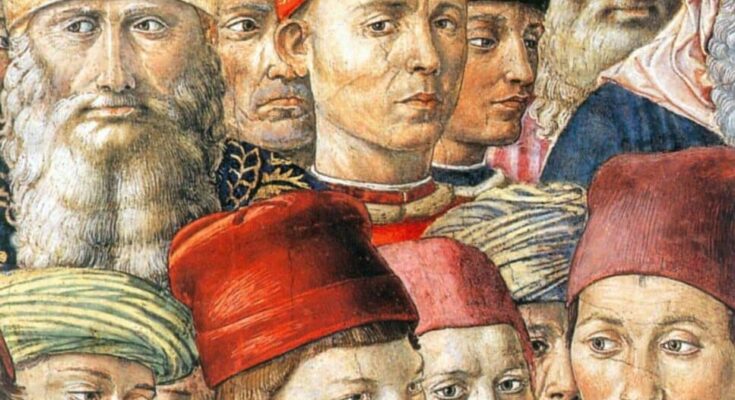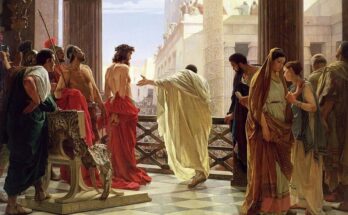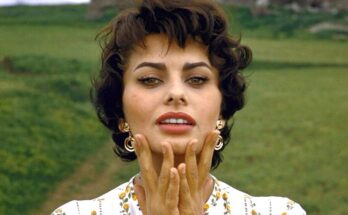
Greeks have a tendency to forget great men of the country who changed the course of history through their words and actions. This is especially the case with men such as Georgios Gemistos, also commonly known as the philosopher Pletho.
Alexandros Papadiamantis wrote:
“Some stages away from Sparta lay the ‘Plethonian’ cave, where Georgios Gemistos, who was renamed ‘Pletho,’ resided, and whose fame was then widespread throughout Greece. Georgios Gemistos was the last great Greek Platonist philosopher of the 15th century, who dreamed of restarting in his time the work of Julian, the one after the Apostate, a second Apostate. Georgios Gemistos was a man of great wisdom and immense learning. He was as far ahead of the time he lived in as the ancient era was superior to the wretched era of his time, and as that miserable era was nonetheless superior to the undefined era of today.”
Biography and early education of Pletho
Georgios Gemistos was born in Constantinople in 1355 to a wealthy, noble family. This gave him the opportunity to acquire a significant education and have access to a multitude of books. His place of birth is certified by his own student, Bessarion, who refers to him as “Constantinopolitanum.” Doukas, however, considers Sparta to be Gemistos’ homeland, a view that Sathas adopts.
Georgios Gemistos’ father, Dimitrios, had served as prothonotary of Hagia Sophia in Constantinople at the end of the 14th and the beginning of the 15th century.
Gemistos’ intellectual formation began with the standard Byzantine aristocratic education program. He studied the trivium—grammar, logic, and rhetoric—and the quadrivium—arithmetic, geometry, astronomy, and music.
Alongside this formal education, he systematically explored historical, geographical, and astronomical subjects. He examined the oracles of the Chaldeans based on Neoplatonic philosophers, such as Iamblichus, Proclus, Simplicius, and Damascius. His main focus was on Platonism and Neoplatonism.
He also studied classical writings by Xenophon, Diodorus Siculus, Theophrastus, Polybius, and especially Plutarch, who influenced him in many ways. His admiration of Plato among Greek philosophers was so profound that he changed his name from Georgios Gemistos to Pletho, a name he felt evoked the ancient philosopher. In Greek, Pletho means “I am, or become, full of something.”
Pletho’s approach to philosophy in his younger years
There is no sufficient information on Gemistos’ teachers and activities in his youth, but we do know he studied under the leading scholar Dimitrios Kydonis, who influenced him tremendously in various ways.
Kydonis was the one who instilled a general love for philosophy in Gemistos as well as for Plato in particular. In addition to this, Gemistos received a pluralistic education from Kydonis, characteristic of scholarship at that time. As a translator of the philosopher Thomas Aquinas, Kydonis knew Latin and Greek as well as scholastic philosophy, which Pletho also studied.
Restless and inquisitive, he traveled to many regions and encountered various cultures and religions. During his trip to Ottoman-occupied Adrianople, he came into contact with Islam and Ottoman culture. This allowed him to attain a better understanding not only of the nature of the external threat to the Byzantine state but also of the internal enemy. This included the corrupt imperial system and significant economic and political influence of the Patriarchate of Constantinople.
The influence of the philosopher Elissaios
According to information preserved by his opponent Gennadios Scholarios, when the philosopher Pletho was in Adrianople, the European capital of the Ottoman Empire, he was apprenticed to Elissaios. Elissaios was a Jew with great knowledge of the Greek language who introduced him to the teachings of Zoroaster.
According to Scholarios’ writings, Elissaios, who was a Hellenist, introduced Pletho to Polytheism. Scholarios mentions this in his letter to Exarchus, in which he attempts to justify his decision to burn his book, Laws. Elissaios was reportedly executed by the Turks.
However, Gemistos’ knowledge of Zoroastrianism appears to have been influenced by Greek sources such as Plutarch, Neoplatonists, and Michael Psellos. Gemistos concluded that without significant changes to the polity and necessary spiritual, economic, and social reforms, the Empire was doomed.
Manuel Palaiologos appreciates the wisdom of the Greek philosopher
With the death of Ioannis V Palaiologos in 1391 and the coronation of Manuel V Palaiologos, the philosopher king, favorable circumstances arose for Gemistos and the emperor to meet and form a mutual friendship.
Manuel appreciated and recognized the Greek education and literacy of the philosopher Pletho. Around 1407, Pletho fled to Mystras, where he was safe and placed under the protection of the Paleologi. They, recognizing his knowledge and abilities, assigned him to various offices.
The death of Theodoros I occurred in the summer of 1407, and Manuel immediately appointed the young Theodoros II Despot under the tutelage of the grand duke Manuel Fragopoulos. Gemistos took on the role of the young Despot’s advisor following Manuel’s order.
The Despot Theodoros himself expressly declares this in his silver bullion in 1433 when he writes: “The one familiar to my kingdom, Mr. Georgios Gemistos, came before these years of his appointment from my father and is in our service.” The office that was covered refers to the the supreme judicial functionary.
This reference is based on the testimony of Gregory the Monk. Gregory, in his Monodia, characterizes the Polyhistor of Mystras as “the highest judge of the Greeks.” From other sources, it appears that Gemistos was also a member of the Synod, whose existence in the Despotate of Mystra is indeed mentioned. The Despot and the emperor granted him land areas of the Despotate, and, subsequently, Gemistos assumed the office of the “head” of the area.
Virtue and justice in a state: the only source of success
Gemistos’ transition to Mystra occurred during a remarkable philological and spiritual renaissance. The flourishing of the arts, painting, and iconography in the 13th and 14th centuries is particularly noteworthy. Classical Letters were not forgotten but were taught intensively and considered essential for a well-rounded education.
As Vasiliev points out, “The court of the Despotate, in the castle of Mystra, was an educational center that attracted educated Greek scholars, sophists, and courtiers.”
In his letters to Theodore, John, and Emperor Manuel Palaiologos, he gives a historical, philosophical and ideological background regarding the need for a good state. For Pletho, the leader of a state must not seek what seems pleasing. Instead, he needs to act as a physician and impose what is right even if it is painful either for the governed or the leaders.
In his letters to the Paleologi, Pletho references great nations and cities known for their historical conquests. He narrates the history of the Arabs, Romans, Persians, Spartans (and the rest of the Greeks), and especially the Turks.
He uses these examples to justify their power and dominance with a clear rule:
“All great nations and peoples, when they dominated everything, succeeded because they had virtuous and just states with correct laws, morals, and customs. Their collapse came from corruption and neglect by both the people and their leaders. Therefore, the goal of the Roman (Byzantine) emperors must be to reshape the state into a just one, with citizens willing to defend it.”
Proposals for reformation: The only way for the Greeks to face the Turkish threat
Pletho argues that this is the only way to deal with the Turks, whom he calls “Parapamisades” (meaning they originated from Central Asia). He mentions that “Alexander, the son of Philip, and the Greeks” once counseled and defeated them in battle.
According to Pletho, this battle was part of their attempt to advance towards India. “Now, after a long time, the Turks impose much larger punishments on the Greeks as revenge for the suffering they inflicted.”
To address the dire situation in the Peloponnese, Pletho proposed several radical measures. These measures were unprecedented for his time and the despotic state of Byzantium. He analyzed numerous forms of government (monarchy, aristocracy, democracy), outlining their properties as well as their advantages and disadvantages.
Pletho’s proposals were ahead of his time
From Mystras, he would send a memorandum to the Palaiologi. In his writings, he recognizes both the ugly state of the empire and the lack of consensus. He also talks about the disfigurement and corruption that prevails in the Peloponnese and puts forth radical proposals for reforms.
He considered monarchy the safest option for his times. However, he also believed the monarch should be a philosopher not seduced by wealth and pleasures. The ruler should avoid luxury and act with prudence for the good of the state. He should also possess as little wealth as possible.
Pletho’s most radical proposal was the common ownership of land and the abolition of landowners. This measure aimed to relieve farmers who belonged to the most oppressed class at the time. He suggested that land be owned only by those who work it. He even adds that ownership should be temporary, based on the period of work. His views bear a striking resemblance to some socialist proposals of the 19th century.
Pletho sought to establish a nation-state starting with the Peloponnese and to gradually re-hellenize other regions. The core would be the Peloponnese, and he considered it urgent to build fortifications at the six miles in Corinth to prevent a future Ottoman invasion.
He also proposed the abolition of mercenary armies and creation of a national Greek army. His ideas on nation-state creation and a national army were particularly progressive for his time.
As a philosopher, Pletho was also known for his unique humanitarian ideals inspired from ancient Greek writers. He argued for the abolition of torture and mutilation, deeming them “barbaric and not Hellenic.”
Furthermore, he advocated for the rationalization of taxation, primarily through the imposition of a national currency and the prohibition of foreign currencies. This, he believed, would naturally boost commerce and craftsmanship.
He called for the taxation of monasteries and criticized the contradiction of monks’ declaring themselves “honest” and blessed by God while relying on public funds for their needs, labeling them as “parasites” of the state.
Pletho’s role in the Council of Florence
Naturally, the Greek philosopher Pletho’s proposals were not heeded. Despite this, the Paleologi consulted him on all important matters. For this reason, at the age of 80, he participated in the commission sent by the Byzantine state to Florence (1438-1439). The aim was to unite the Catholic Church with the Orthodox Church, in an attempt to end the East-West Schism. At this Council, intellectuals concerned about the Ottoman threat to the Greek nation tended to support the Union. In contrast, those who prioritized Christian Orthodox faith believed the Papal Church posed a greater threat to their identity. They fiercely opposed the Union.
At the Council, Pletho, despite secretly not being a Christian, fiercely opposed the Union, viewing it as enslavement to the Papal Church. He considered this scenario equally as detrimental as the enslavement of Greek territory to the Turks, since it opposed his vision of a political and cultural revival of Hellenism.

Pletho’s theological and Platonic philosophical views that led him to oppose Unity of Churches
Beyond the obvious political reasons for opposing the Union of the Churches, Pletho also had philosophical and theological grounds rooted in his unique Platonic philosophy.
In Platonic philosophy and theology and the tradition of the Eleusinian mysteries, the divine essence is eternal and immortal. It is also universally indivisible, and ultimately impersonal, unlike the God of the Abrahamic religions, who is a personal deity with anthropomorphic traits.
In this view, all human beings, without exception, partake in the divine through their immortal souls. Just like Plato’s theory that all humans possess a divine or heavenly nature.
Thus, Orthodox teachings and traditions, which hold that the Holy Spirit emanates only from the Father and not from the Son (in contrast to the Filioque doctrine of the Roman Catholic Church), were more compatible with Pletho’s polytheistic Platonism.
In this philosophy, all living beings share in the divine providence and nature. This was in contrast with the Roman Catholic doctrine of the Holy Spirit’s emanation from the Son, which tended to personify the divine nature.
His work, “On the Outpouring of the Holy Spirit,” though written against the Latins, was not well received by the Eastern Church. Manuel the Peloponnesian, in a letter to the emperor, described Pletho as “godless” and “conceited,” and claimed that the book was written “subserviently,” with the intent of “mocking” the Orthodox faith and acting “against us Christians.”
For his opponent, Gennadius Scholarius, this writing was a clear “indication” of Pletho’s turn toward the polytheistic thought of ancient paganism, in line with Platonic teachings, and a departure from Christian doctrine.
Last years of the Greek philosopher Pletho’s life
In the last years of his life, Pletho faced opposition from his former student, Gennadius Scholarius, who later became the Patriarch of Constantinople. Scholarius accused him of paganism and attempting to convert Greeks to the old religion. He even went so far as to publicly burn Pletho’s work, “Laws,” after his death, arguing that the ideas presented in it clearly opposed Christian teachings.
In “Laws,” Pletho attributed divine status to the heavens, planets, and stars. The philosopher believed them to have immortal souls, along with the entire universe, according to the principles of Greek mythology.
He embraced the cosmology of ancient Greek religion and Platonic philosophy. He viewed the world as a “jewel”—a material manifestation of eternal and immortal divine archetypes of an impersonal creator. These divine archetypes, Plato referred to as Ideas or Forms (Plato’s theory of ideas).
Pletho also accepted the doctrine of the eternity of the universe, of matter, decay, and birth, directly opposing the idea of creation ex nihilo as taught in the Bible. The Christian doctrine of the afterlife conflicted with Platonic beliefs in the reincarnation of immortal souls.
Pletho, by adopting Greek philosophical views, in contrast to the views of “sophists” (a name with which he labels the Christians), argued that for a real philosopher there is no eternal damnation; instead, human souls would return to life in different bodies. He thereby rejecting Christian eschatology regarding the Second Coming and Resurrection.
Moreover, Pletho had already criticized Aristotelianism, the philosophical current that was deeply integrated into both Roman Catholic and Orthodox traditions. This criticism aroused Scholarius’s suspicions about Pletho’s pagan tendencies.
According to Sathas, during that period, the church viewed Plato with suspicion as the most “dangerous” philosopher, believing that his teachings could lead readers to “idolatry.”
Death and burial of Pletho in Tempio Malatestiano
Pletho passed away on June 26, 1452, as recorded in a relevant manuscript. He did not live to see the Ottoman conquest of the Greek territories and the fall of the Byzantine Empire. When the Italian Sigismondo Malatesta discovered Pletho’s neglected tomb in Morea, he decided to transfer his remains to Italy.
The body of the great Greek philosopher Pletho now rests in the Church of Saint Francis (Tempio Malatestiano) in Rimini. Many of his students, including Bessarion, Laonikos Chalkokondylis, Ioannis Argyropoulos, and others, fled to Italy after the Ottoman conquest. They continued to pass on Pletho’s teachings, becoming cornerstones of Humanism and the Renaissance in the West.
During his stay in Florence for the Council of 1438-1439, Pletho had already exerted significant influence on the Florentine intellectual scene through his interactions with Cosimo de’ Medici.
Inspired by Platonic teachings, Cosimo financed the establishment of the Neoplatonic Academy of Florence. To do so, he collaborated with the Humanist philosopher Marsilio Ficino. This academy became one of the most important centers of the Renaissance in the West. It also played a pivotal role in the reintroduction of Platonism to Europe.

.



